check engine SKODA YETI 2011 1.G / 5L User Guide
[x] Cancel search | Manufacturer: SKODA, Model Year: 2011, Model line: YETI, Model: SKODA YETI 2011 1.G / 5LPages: 252, PDF Size: 3.61 MB
Page 88 of 252
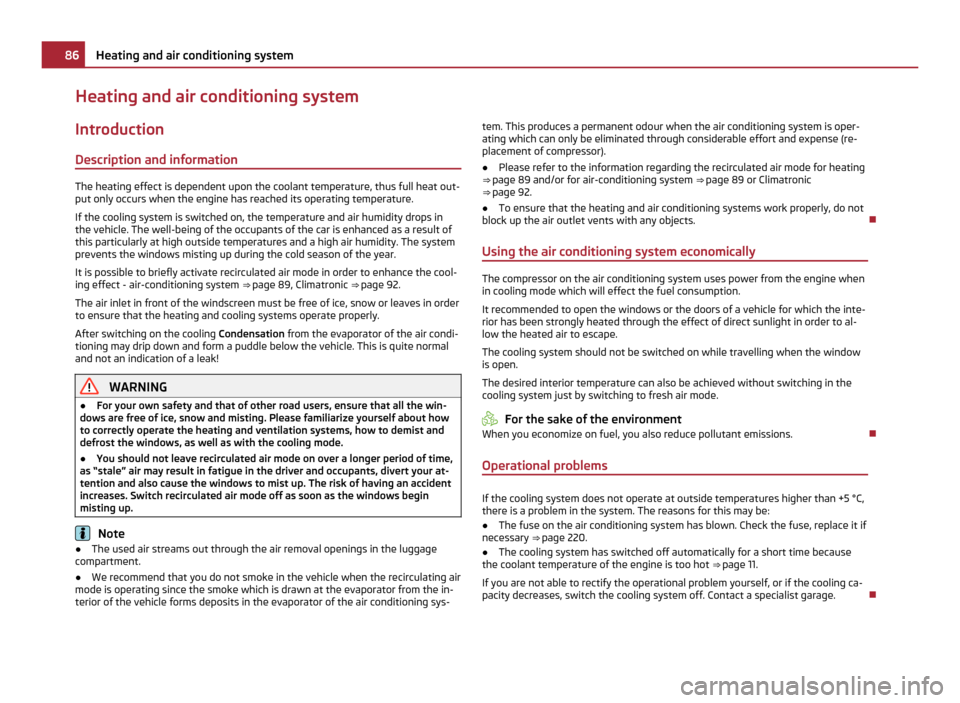
Heating and air conditioning system
Introduction
Description and information The heating effect is dependent upon the coolant temperature, thus full heat out-
put only occurs when the engine has reached its operating temperature.
If the cooling system is switched on, the temperature and air humidity drops in
the vehicle. The well-being of the occupants of the car is enhanced as a result of
this particularly at high outside temperatures and a high air humidity. The system
prevents the windows misting up during the cold season of the year.
It is possible to briefly activate recirculated air mode in order to enhance the cool-
ing effect - air-conditioning system ⇒
page 89, Climatronic ⇒ page 92.
The air inlet in front of the windscreen must be free of ice, snow or leaves in order
to ensure that the heating and cooling systems operate properly.
After switching on the cooling Condensation from the evaporator of the air condi-
tioning may drip down and form a puddle below the vehicle. This is quite normal
and not an indication of a leak! WARNING
● For your own safety and that of other road users, ensure that all the win-
dows are free of ice, snow and misting. Please familiarize yourself about how
to correctly operate the heating and ventilation systems, how to demist and
defrost the windows, as well as with the cooling mode.
● You should not leave recirculated air mode on over a longer period of time,
as
“stale” air may result in fatigue in the driver and occupants, divert your at-
tention and also cause the windows to mist up. The risk of having an accident
increases. Switch recirculated air mode off as soon as the windows begin
misting up. Note
● The used air streams out through the air removal openings in the luggage
compartment.
● We recommend that you do not smoke in the vehicle when the recirculating air
mode is operating since the smoke which is drawn at the evaporator from the in-
terior of the vehicle forms deposits in the evaporator of the air conditioning sys- tem. This produces a permanent odour when the air conditioning system is oper-
ating which can only be eliminated through considerable effort and expense (re-
placement of compressor).
● Please refer to the information regarding the recirculated air mode for heating
⇒
page 89 and/or for air-conditioning system ⇒ page 89 or Climatronic
⇒ page 92.
● To ensure that the heating and air conditioning systems work properly, do not
block up the air outlet vents with any objects.
Using the air conditioning system economically The compressor on the air conditioning system uses power from the engine when
in cooling mode which will effect the fuel consumption.
It recommended to open the windows or the doors of a vehicle for which the inte-
rior has been strongly heated through the effect of direct sunlight in order to al-
low the heated air to escape.
The cooling system should not be switched on while travelling when the window
is open.
The desired interior temperature can also be achieved without switching in the
cooling system just by switching to fresh air mode. For the sake of the environment
When you economize on fuel, you also reduce pollutant emissions.
Operational problems If the cooling system does not operate at outside temperatures higher than +5 °C,
there is a problem in the system. The reasons for this may be:
●
The fuse on the air conditioning system has blown. Check the fuse, replace it if
necessary ⇒ page 220.
● The cooling system has switched off automatically for a short time because
the coolant temperature of the engine is too hot ⇒ page 11.
If you are not able to rectify the operational problem yourself, or if the cooling ca-
pacity decreases, switch the cooling system off. Contact a specialist garage. 86
Heating and air conditioning system
Page 101 of 252

Starting-off and Driving
Setting steering wheel position Fig. 95 Adjustable steering wheel: Lever next to the steering column/safe distance to the
steering wheel
You can set the height and the forward/back position of the steering wheel to the
desired position.
– Adjust the driver seat ⇒ page 61.
– Pull the lever below the steering wheel down ⇒ fig. 95 - left ⇒ .
– Set the steering wheel to the desired position (concerning height and forward/
back position).
– Push the lever upwards as far as the stop. WARNING
● You must not adjust the steering wheel when the vehicle is moving!
● The driver must maintain a distance of at least 25 cm to the steering wheel
⇒ fig. 95 - right. Not maintaining this minimum distance will mean that the air-
bag system will not be able to properly protect you - hazard!
● For safety reasons the lever must always be firmly pushed up to avoid the
steering wheel altering its position unintentionally when driving - risk of acci-
dent! WARNING (Continued)
● If you adjust the steering wheel further towards the head, you will reduce
the protection offered by the driver airbag in the event of an accident. Check
that the steering wheel is aligned to the chest.
● When driving, hold the steering wheel with both hands firmly on the outer
edge in the 9 o'clock and 3 o'clock position. Never hold the steering wheel
firmly in the 12 o'clock position or in another way (e.g. in the middle of the
steering wheel or at the inner steering wheel edge). In such cases, injuries to
the arms, the hands and the head can occur when the driver airbag is de-
ployed.
Ignition lock Fig. 96 Ignition lock positions
Petrol engines 1 - ignition switched off, engine off, the steering can be locked.
2 - ignition switched on
3 - start engine
Diesel engines 1 - interruption of fuel supply, ignition switched off, engine off, the steering can
be locked.
2 - heating glow plugs on, ignition switched on
● You should not switch on any major electrical components during the heating
period otherwise the vehicle battery will be drained unnecessarily. £ 99
Starting-off and Driving Using the system Safety Driving Tips General Maintenance Breakdown assistance Technical data
Page 103 of 252
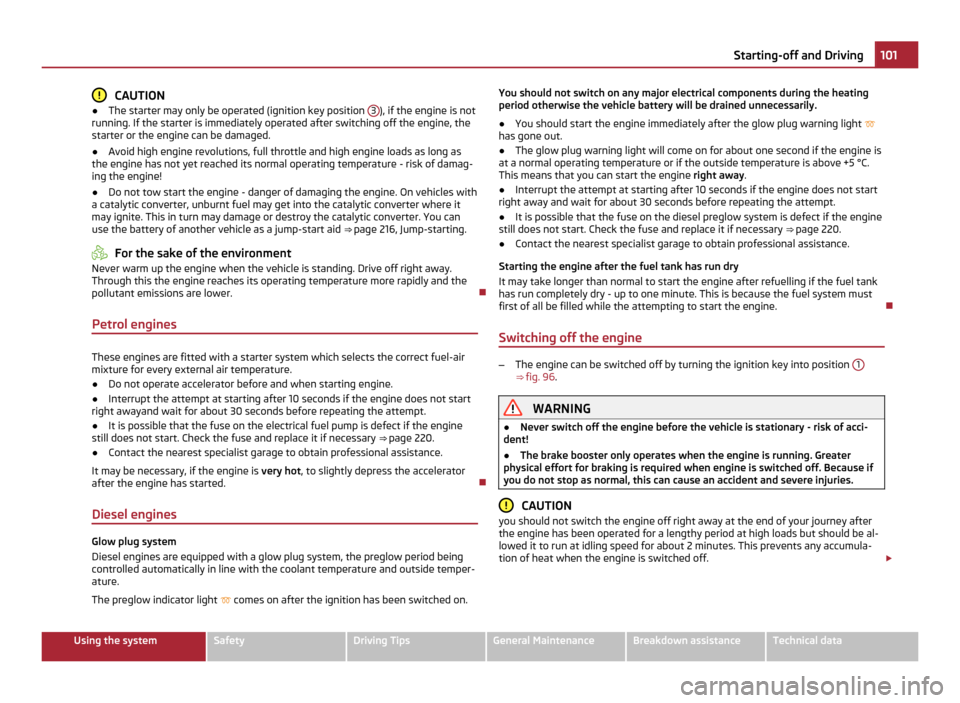
CAUTION
● The starter may only be operated (ignition key position 3 ), if the engine is not
running. If the starter is immediately operated after switching off the engine, the
starter or the engine can be damaged.
● Avoid high engine revolutions, full throttle and high engine loads as long as
the engine has not yet reached its normal operating temperature - risk of damag-
ing the engine!
● Do not tow start the engine - danger of damaging the engine. On vehicles with
a catalytic converter, unburnt fuel may get into the catalytic converter where it
may ignite. This in turn may damage or destroy the catalytic converter. You can
use the battery of another vehicle as a jump-start aid ⇒ page 216, Jump-starting
.For the sake of the environment
Never warm up the engine when the vehicle is standing. Drive off right away.
Through this the engine reaches its operating temperature more rapidly and the
pollutant emissions are lower.
Petrol engines These engines are fitted with a starter system which selects the correct fuel-air
mixture for every external air temperature.
●
Do not operate accelerator before and when starting engine.
● Interrupt the attempt at starting after 10 seconds if the engine does not start
right awayand wait for about 30 seconds before repeating the attempt.
● It is possible that the fuse on the electrical fuel pump is defect if the engine
still does not start. Check the fuse and replace it if necessary ⇒ page 220.
● Contact the nearest specialist garage to obtain professional assistance.
It may be necessary, if the engine is very hot, to slightly depress the accelerator
after the engine has started.
Diesel engines Glow plug system
Diesel engines are equipped with a glow plug system, the preglow period being
controlled automatically in line with the coolant temperature and outside temper-
ature.
The preglow indicator light comes on after the ignition has been switched on. You should not switch on any major electrical components during the heating
period otherwise the vehicle battery will be drained unnecessarily.
● You should start the engine immediately after the glow plug warning light
has gone out.
● The glow plug warning light will come on for about one second if the engine is
at a normal operating temperature or if the outside temperature is above +5 °C.
This means that you can start the engine right away.
● Interrupt the attempt at starting after 10 seconds if the engine does not start
right away and wait for about 30 seconds before repeating the attempt.
● It is possible that the fuse on the diesel preglow system is defect if the engine
still does not start. Check the fuse and replace it if necessary ⇒ page 220.
● Contact the nearest specialist garage to obtain professional assistance.
Starting the engine after the fuel tank has run dry
It may take longer than normal to start the engine after refuelling if the fuel tank
has run completely dry - up to one minute. This is because the fuel system must
first of all be filled while the attempting to start the engine.
Switching off the engine –
The engine can be switched off by turning the ignition key into position 1 ⇒
fig. 96 . WARNING
● Never switch off the engine before the vehicle is stationary - risk of acci-
dent!
● The brake booster only operates when the engine is running. Greater
physical effort for braking is required when engine is switched off. Because if
you do not stop as normal, this can cause an accident and severe injuries. CAUTION
you should not switch the engine off right away at the end of your journey after
the engine has been operated for a lengthy period at high loads but should be al-
lowed it to run at idling speed for about 2
minutes. This prevents any accumula-
tion of heat when the engine is switched off. £ 101
Starting-off and Driving Using the system Safety Driving Tips General Maintenance Breakdown assistance Technical data
Page 112 of 252
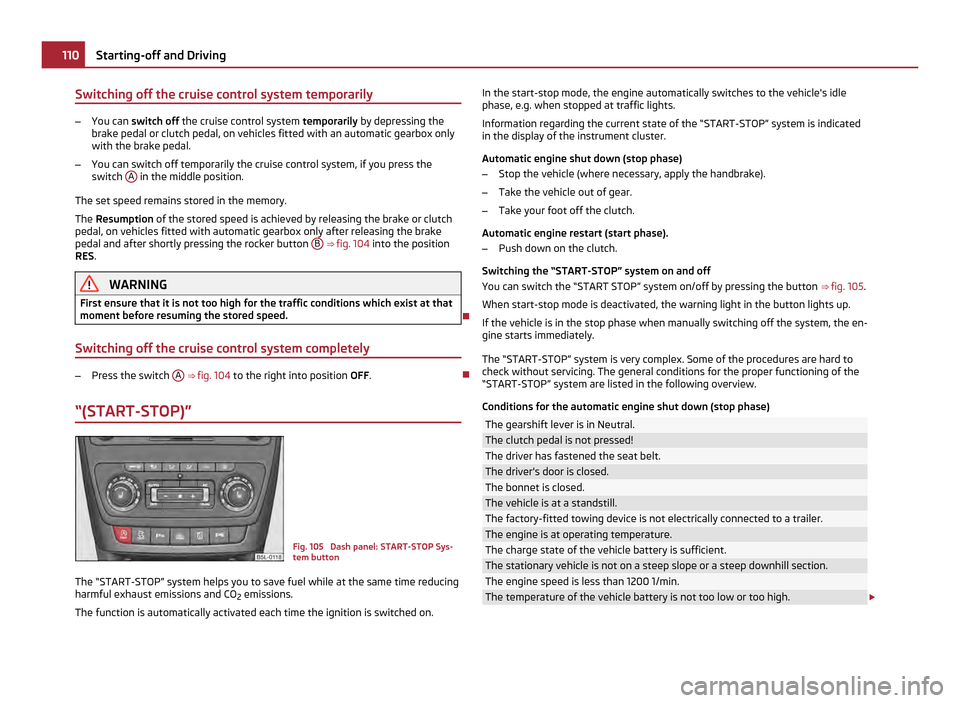
Switching off the cruise control system temporarily
–
You can switch off the cruise control system temporarily by depressing the
brake pedal or clutch pedal, on vehicles fitted with an automatic gearbox only
with the brake pedal.
– You can switch off temporarily the cruise control system, if you press the
switch A in the middle position.
The set speed remains stored in the memory.
The Resumption of the stored speed is achieved by releasing the brake or clutch
pedal, on vehicles fitted with automatic gearbox only after releasing the brake
pedal and after shortly pressing the rocker button B
⇒ fig. 104 into the position
RES. WARNING
First ensure that it is not too high for the traffic conditions which exist at that
moment before resuming the stored speed.
Switching off the cruise control system completely –
Press the switch A
⇒ fig. 104
to the right into position OFF.
“(START-STOP)” Fig. 105 Dash panel: START-STOP Sys-
tem button
The “START-STOP” system helps you to save fuel while at the same time reducing
harmful exhaust emissions and CO 2 emissions.
The function is automatically activated each time the ignition is switched on. In the start-stop mode, the engine automatically switches to the vehicle's idle
phase, e.g. when stopped at traffic lights.
Information regarding the current state of the
“START-STOP” system is indicated
in the display of the instrument cluster.
Automatic engine shut down (stop phase)
– Stop the vehicle (where necessary, apply the handbrake).
– Take the vehicle out of gear.
– Take your foot off the clutch.
Automatic engine restart (start phase).
– Push down on the clutch.
Switching the
“START-STOP” system on and off
You can switch the “START STOP” system on/off by pressing the button ⇒ fig. 105 .
When start-stop mode is deactivated, the warning light in the button lights up.
If the vehicle is in the stop phase when manually switching off the system, the en-
gine starts immediately.
The “START-STOP” system is very complex. Some of the procedures are hard to
check without servicing. The general conditions for the proper functioning of the
“START-STOP” system are listed in the following overview.
Conditions for the automatic engine shut down (stop phase) The gearshift lever is in Neutral.
The clutch pedal is not pressed!
The driver has fastened the seat belt.
The driver's door is closed.
The bonnet is closed.
The vehicle is at a standstill.
The factory-fitted towing device is not electrically connected to a trailer.
The engine is at operating temperature.
The charge state of the vehicle battery is sufficient.
The stationary vehicle is not on a steep slope or a steep downhill section.
The engine speed is less than 1200 1/min.
The temperature of the vehicle battery is not too low or too high.
£110
Starting-off and Driving
Page 161 of 252
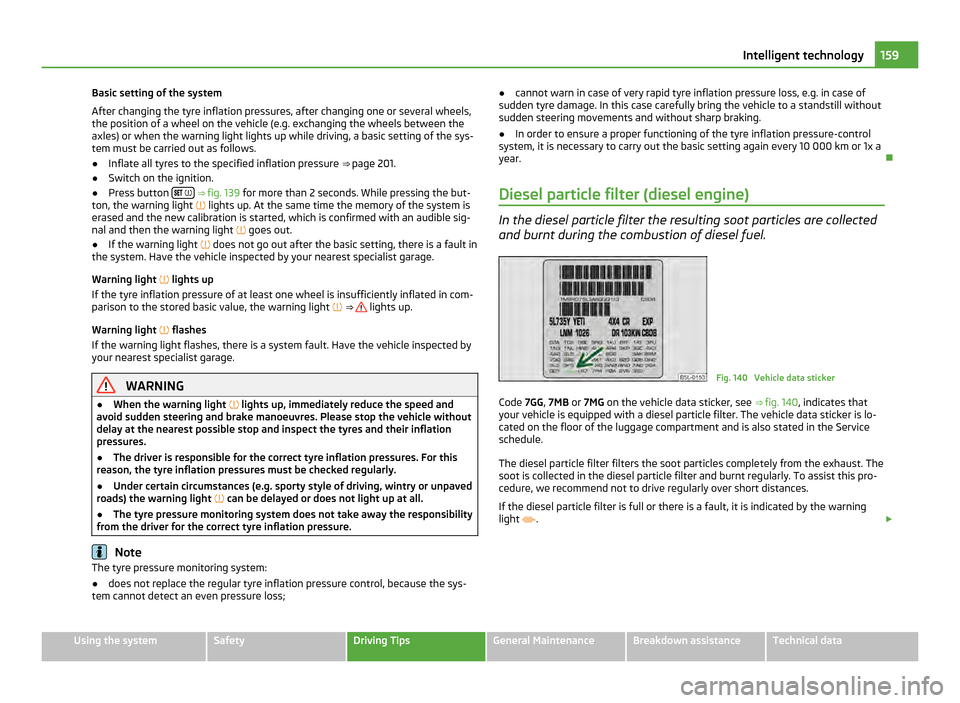
Basic setting of the system
After changing the tyre inflation pressures, after changing one or several wheels,
the position of a wheel on the vehicle (e.g. exchanging the wheels between the
axles) or when the warning light lights up while driving, a basic setting of the sys-
tem must be carried out as follows.
● Inflate all tyres to the specified inflation pressure ⇒ page 201.
● Switch on the ignition.
● Press button
⇒ fig. 139
for more than 2
seconds. While pressing the but-
ton, the warning light lights up. At the same time the memory of the system is
erased and the new calibration is started, which is confirmed with an audible sig-
nal and then the warning light goes out.
● If the warning light does not go out after the basic setting, there is a fault in
the system. Have the vehicle inspected by your nearest specialist garage.
Warning light lights up
If the tyre inflation pressure of at least one wheel is insufficiently inflated in com-
parison to the stored basic value, the warning light ⇒ lights up.
Warning light flashes
If the warning light flashes, there is a system fault. Have the vehicle inspected by
your nearest specialist garage. WARNING
● When the warning light lights up, immediately reduce the speed and
avoid sudden steering and brake manoeuvres. Please stop the vehicle without
delay at the nearest possible stop and inspect the tyres and their inflation
pressures.
● The driver is responsible for the correct tyre inflation pressures. For this
reason, the tyre inflation pressures must be checked regularly.
● Under certain circumstances (e.g. sporty style of driving, wintry or unpaved
roads) the warning light can be delayed or does not light up at all.
● The tyre pressure monitoring system does not take away the responsibility
from the driver for the correct tyre inflation pressure. Note
The tyre pressure monitoring system:
● does not replace the regular tyre inflation pressure control, because the sys-
tem cannot detect an even pressure loss; ●
cannot warn in case of very rapid tyre inflation pressure loss, e.g. in case of
sudden tyre damage. In this case carefully bring the vehicle to a standstill without
sudden steering movements and without sharp braking.
● In order to ensure a proper functioning of the tyre inflation pressure-control
system, it is necessary to carry out the basic setting again every 10 000 km or 1x a
year.
Diesel particle filter (diesel engine) In the diesel particle filter the resulting soot particles are collected
and burnt during the combustion of diesel fuel. Fig. 140 Vehicle data sticker
Code 7GG , 7MB or 7MG on the vehicle data sticker, see ⇒ fig. 140 , indicates that
your vehicle is equipped with a diesel particle filter. The vehicle data sticker is lo-
cated on the floor of the luggage compartment and is also stated in the Service
schedule.
The diesel particle filter filters the soot particles completely from the exhaust. The
soot is collected in the diesel particle filter and burnt regularly. To assist this pro-
cedure, we recommend not to drive regularly over short distances.
If the diesel particle filter is full or there is a fault, it is indicated by the warning
light . £ 159
Intelligent technology Using the system Safety Driving Tips General Maintenance Breakdown assistance Technical data
Page 167 of 252
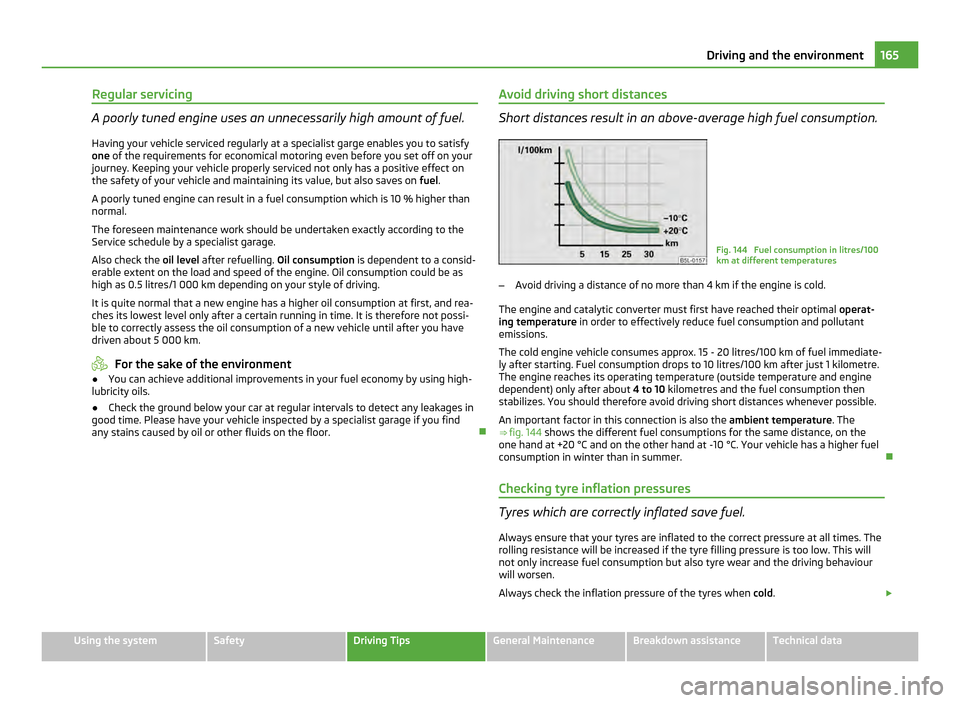
Regular servicing
A poorly tuned engine uses an unnecessarily high amount of fuel.
Having your vehicle serviced regularly at a specialist garge enables you to satisfy
one of the requirements for economical motoring even before you set off on your
journey. Keeping your vehicle properly serviced not only has a positive effect on
the safety of your vehicle and maintaining its value, but also saves on fuel.
A poorly tuned engine can result in a fuel consumption which is 10 % higher than
normal.
The foreseen maintenance work should be undertaken exactly according to the
Service schedule by a specialist garage.
Also check the oil level after refuelling. Oil consumption is dependent to a consid-
erable extent on the load and speed of the engine. Oil consumption could be as
high as 0.5 litres/1 000 km depending on your style of driving.
It is quite normal that a new engine has a higher oil consumption at first, and rea-
ches its lowest level only after a certain running in time. It is therefore not possi-
ble to correctly assess the oil consumption of a new vehicle until after you have
driven about 5 000 km. For the sake of the environment
● You can achieve additional improvements in your fuel economy by using high-
lubricity oils.
● Check the ground below your car at regular intervals to detect any leakages in
good time. Please have your vehicle inspected by a specialist garage if you find
any stains caused by oil or other fluids on the floor. Avoid driving short distances Short distances result in an above-average high fuel consumption.
Fig. 144 Fuel consumption in litres/100
km at different temperatures
– Avoid driving a distance of no more than 4 km if the engine is cold.
The engine and catalytic converter must first have reached their optimal operat-
ing temperature in order to effectively reduce fuel consumption and pollutant
emissions.
The cold engine vehicle consumes approx. 15 - 20 litres/100 km of fuel immediate-
ly after starting. Fuel consumption drops to 10 litres/100 km after just 1 kilometre.
The engine reaches its operating temperature (outside temperature and engine
dependent) only after about 4 to 10 kilometres and the fuel consumption then
stabilizes. You should therefore avoid driving short distances whenever possible.
An important factor in this connection is also the ambient temperature. The
⇒ fig. 144 shows the different fuel consumptions for the same distance, on the
one hand at +20 °C and on the other hand at -10
°C. Your vehicle has a higher fuel
consumption in winter than in summer.
Checking tyre inflation pressures Tyres which are correctly inflated save fuel.
Always ensure that your tyres are inflated to the correct pressure at all times. The
rolling resistance will be increased if the tyre filling pressure is too low. This will
not only increase fuel consumption but also tyre wear and the driving behaviour
will worsen.
Always check the inflation pressure of the tyres when cold. £ 165
Driving and the environment Using the system Safety Driving Tips General Maintenance Breakdown assistance Technical data
Page 168 of 252
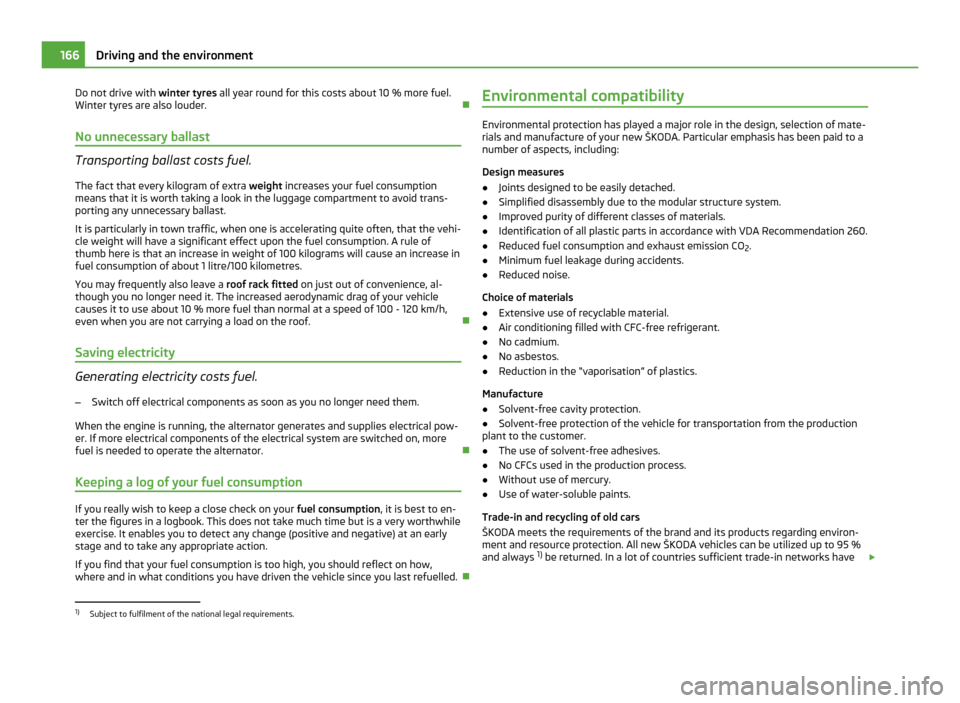
Do not drive with winter tyres all year round for this costs about 10 % more fuel.
Winter tyres are also louder.
No unnecessary ballast Transporting ballast costs fuel.
The fact that every kilogram of extra weight increases your fuel consumption
means that it is worth taking a look in the luggage compartment to avoid trans-
porting any unnecessary ballast.
It is particularly in town traffic, when one is accelerating quite often, that the vehi-
cle weight will have a significant effect upon the fuel consumption. A rule of
thumb here is that an increase in weight of 100 kilograms will cause an increase in
fuel consumption of about 1 litre/100 kilometres.
You may frequently also leave a roof rack fitted on just out of convenience, al-
though you no longer need it. The increased aerodynamic drag of your vehicle
causes it to use about 10 % more fuel than normal at a speed of 100 - 120 km/h,
even when you are not carrying a load on the roof.
Saving electricity Generating electricity costs fuel.
– Switch off electrical components as soon as you no longer need them.
When the engine is running, the alternator generates and supplies electrical pow-
er. If more electrical components of the electrical system are switched on, more
fuel is needed to operate the alternator.
Keeping a log of your fuel consumption If you really wish to keep a close check on your
fuel consumption, it is best to en-
ter the figures in a logbook. This does not take much time but is a very worthwhile
exercise. It enables you to detect any change (positive and negative) at an early
stage and to take any appropriate action.
If you find that your fuel consumption is too high, you should reflect on how,
where and in what conditions you have driven the vehicle since you last refuelled. Environmental compatibility Environmental protection has played a major role in the design, selection of mate-
rials and manufacture of your new ŠKODA. Particular emphasis has been paid to a
number of aspects, including:
Design measures
● Joints designed to be easily detached.
● Simplified disassembly due to the modular structure system.
● Improved purity of different classes of materials.
● Identification of all plastic parts in accordance with VDA Recommendation 260.
● Reduced fuel consumption and exhaust emission CO
2.
● Minimum fuel leakage during accidents.
● Reduced noise.
Choice of materials
● Extensive use of recyclable material.
● Air conditioning filled with CFC-free refrigerant.
● No cadmium.
● No asbestos.
● Reduction in the “vaporisation” of plastics.
Manufacture
● Solvent-free cavity protection.
● Solvent-free protection of the vehicle for transportation from the production
plant to the customer.
● The use of solvent-free adhesives.
● No CFCs used in the production process.
● Without use of mercury.
● Use of water-soluble paints.
Trade-in and recycling of old cars
ŠKODA meets the requirements of the brand and its products regarding environ-
ment and resource protection. All new
ŠKODA vehicles can be utilized up to 95 %
and always 1)
be returned. In a lot of countries sufficient trade-in networks have £1)
Subject to fulfilment of the national legal requirements. 166
Driving and the environment
Page 170 of 252
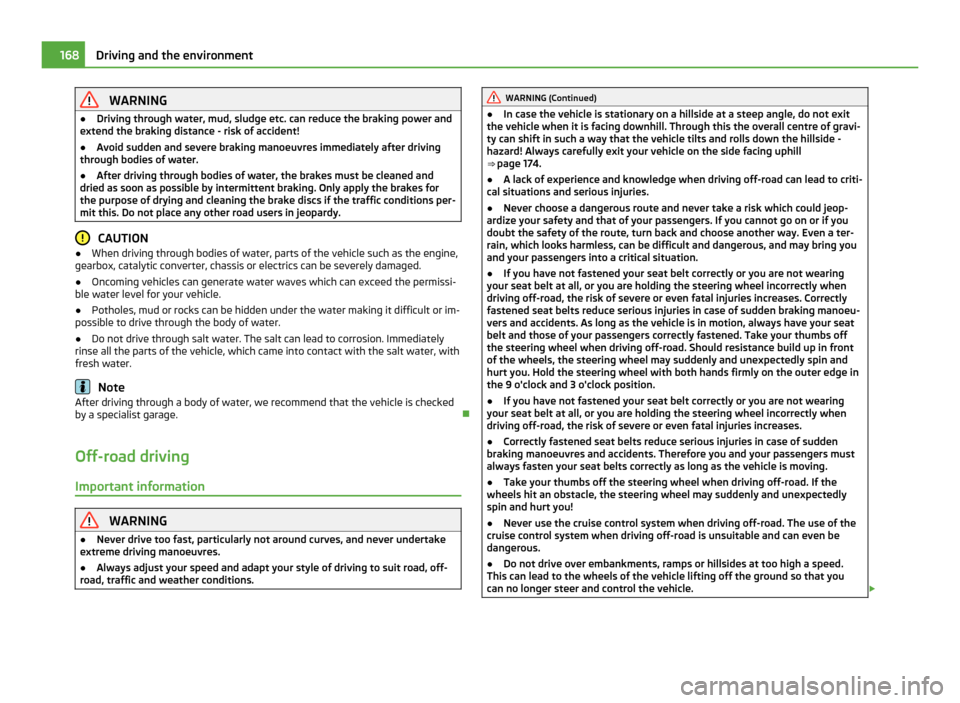
WARNING
● Driving through water, mud, sludge etc. can reduce the braking power and
extend the braking distance - risk of accident!
● Avoid sudden and severe braking manoeuvres immediately after driving
through bodies of water.
● After driving through bodies of water, the brakes must be cleaned and
dried as soon as possible by intermittent braking. Only apply the brakes for
the purpose of drying and cleaning the brake discs if the traffic conditions per-
mit this. Do not place any other road users in jeopardy. CAUTION
● When driving through bodies of water, parts of the vehicle such as the engine,
gearbox, catalytic converter, chassis or electrics can be severely damaged.
● Oncoming vehicles can generate water waves which can exceed the permissi-
ble water level for your vehicle.
● Potholes, mud or rocks can be hidden under the water making it difficult or im-
possible to drive through the body of water.
● Do not drive through salt water. The salt can lead to corrosion. Immediately
rinse all the parts of the vehicle, which came into contact with the salt water, with
fresh water. Note
After driving through a body of water, we recommend that the vehicle is checked
by a specialist garage.
Off-road driving Important information WARNING
● Never drive too fast, particularly not around curves, and never undertake
extreme driving manoeuvres.
● Always adjust your speed and adapt your style of driving to suit road, off-
road, traffic and weather conditions. WARNING (Continued)
● In case the vehicle is stationary on a hillside at a steep angle, do not exit
the vehicle when it is facing downhill. Through this the overall centre of gravi-
ty can shift in such a way that the vehicle tilts and rolls down the hillside -
hazard! Always carefully exit your vehicle on the side facing uphill
⇒ page 174
.
● A lack of experience and knowledge when driving off-road can lead to criti-
cal situations and serious injuries.
● Never choose a dangerous route and never take a risk which could jeop-
ardize your safety and that of your passengers. If you cannot go on or if you
doubt the safety of the route, turn back and choose another way. Even a ter-
rain, which looks harmless, can be difficult and dangerous, and may bring you
and your passengers into a critical situation.
● If you have not fastened your seat belt correctly or you are not wearing
your seat belt at all, or you are holding the steering wheel incorrectly when
driving off-road, the risk of severe or even fatal injuries increases. Correctly
fastened seat belts reduce serious injuries in case of sudden braking manoeu-
vers and accidents. As long as the vehicle is in motion, always have your seat
belt and those of your passengers correctly fastened. Take your thumbs off
the steering wheel when driving off-road. Should resistance build up in front
of the wheels, the steering wheel may suddenly and unexpectedly spin and
hurt you. Hold the steering wheel with both hands firmly on the outer edge in
the 9 o'clock and 3 o'clock position.
● If you have not fastened your seat belt correctly or you are not wearing
your seat belt at all, or you are holding the steering wheel incorrectly when
driving off-road, the risk of severe or even fatal injuries increases.
● Correctly fastened seat belts reduce serious injuries in case of sudden
braking manoeuvres and accidents. Therefore you and your passengers must
always fasten your seat belts correctly as long as the vehicle is moving.
● Take your thumbs off the steering wheel when driving off-road. If the
wheels hit an obstacle, the steering wheel may suddenly and unexpectedly
spin and hurt you!
● Never use the cruise control system when driving off-road. The use of the
cruise control system when driving off-road is unsuitable and can even be
dangerous.
● Do not drive over embankments, ramps or hillsides at too high a speed.
This can lead to the wheels of the vehicle lifting off the ground so that you
can no longer steer and control the vehicle. £168
Driving and the environment
Page 173 of 252
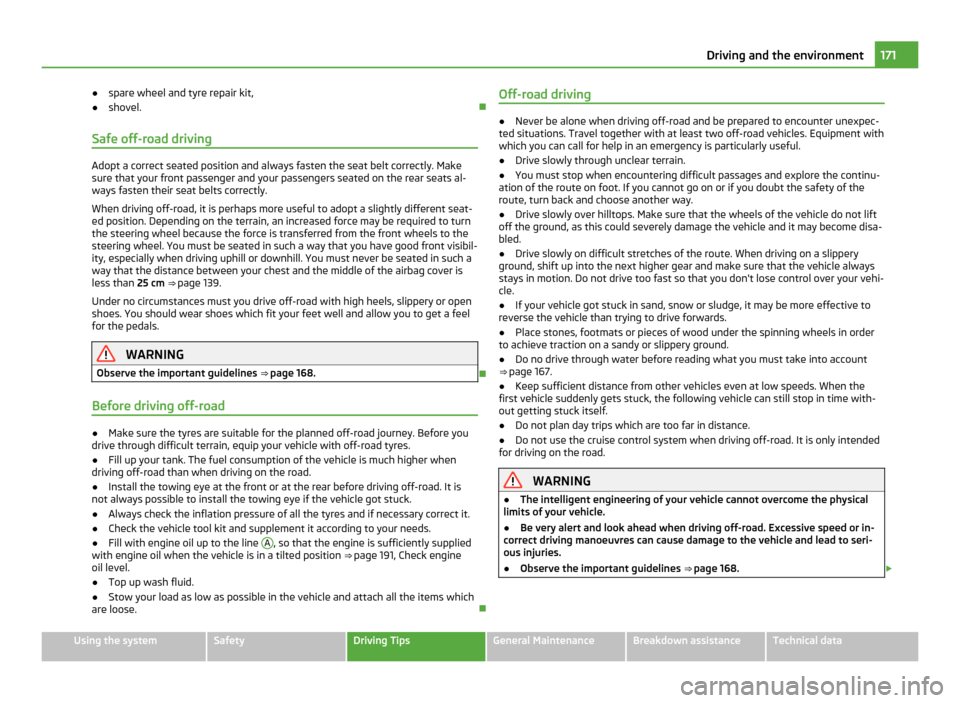
●
spare wheel and tyre repair kit,
● shovel.
Safe off-road driving Adopt a correct seated position and always fasten the seat belt correctly. Make
sure that your front passenger and your passengers seated on the rear seats al-
ways fasten their seat belts correctly.
When driving off-road, it is perhaps more useful to adopt a slightly different seat-
ed position. Depending on the terrain, an increased force may be required to turn
the steering wheel because the force is transferred from the front wheels to the
steering wheel. You must be seated in such a way that you have good front visibil-
ity, especially when driving uphill or downhill. You must never be seated in such a
way that the distance between your chest and the middle of the airbag cover is
less than 25 cm ⇒
page 139.
Under no circumstances must you drive off-road with high heels, slippery or open
shoes. You should wear shoes which fit your feet well and allow you to get a feel
for the pedals. WARNING
Observe the important guidelines ⇒
page 168.
Before driving off-road ●
Make sure the tyres are suitable for the planned off-road journey. Before you
drive through difficult terrain, equip your vehicle with off-road tyres.
● Fill up your tank. The fuel consumption of the vehicle is much higher when
driving off-road than when driving on the road.
● Install the towing eye at the front or at the rear before driving off-road. It is
not always possible to install the towing eye if the vehicle got stuck.
● Always check the inflation pressure of all the tyres and if necessary correct it.
● Check the vehicle tool kit and supplement it according to your needs.
● Fill with engine oil up to the line A , so that the engine is sufficiently supplied
with engine oil when the vehicle is in a tilted position ⇒
page 191, Check engine
oil level.
● Top up wash fluid.
● Stow your load as low as possible in the vehicle and attach all the items which
are loose. Off-road driving ●
Never be alone when driving off-road and be prepared to encounter unexpec-
ted situations. Travel together with at least two off-road vehicles. Equipment with
which you can call for help in an emergency is particularly useful.
● Drive slowly through unclear terrain.
● You must stop when encountering difficult passages and explore the continu-
ation of the route on foot. If you cannot go on or if you doubt the safety of the
route, turn back and choose another way.
● Drive slowly over hilltops. Make sure that the wheels of the vehicle do not lift
off the ground, as this could severely damage the vehicle and it may become disa-
bled.
● Drive slowly on difficult stretches of the route. When driving on a slippery
ground, shift up into the next higher gear and make sure that the vehicle always
stays in motion. Do not drive too fast so that you don't lose control over your vehi-
cle.
● If your vehicle got stuck in sand, snow or sludge, it may be more effective to
reverse the vehicle than trying to drive forwards.
● Place stones, footmats or pieces of wood under the spinning wheels in order
to achieve traction on a sandy or slippery ground.
● Do no drive through water before reading what you must take into account
⇒ page 167.
● Keep sufficient distance from other vehicles even at low speeds. When the
first vehicle suddenly gets stuck, the following vehicle can still stop in time with-
out getting stuck itself.
● Do not plan day trips which are too far in distance.
● Do not use the cruise control system when driving off-road. It is only intended
for driving on the road. WARNING
● The intelligent engineering of your vehicle cannot overcome the physical
limits of your vehicle.
● Be very alert and look ahead when driving off-road. Excessive speed or in-
correct driving manoeuvres can cause damage to the vehicle and lead to seri-
ous injuries.
● Observe the important guidelines ⇒ page 168. £ 171
Driving and the environment Using the system Safety Driving Tips General Maintenance Breakdown assistance Technical data
Page 175 of 252
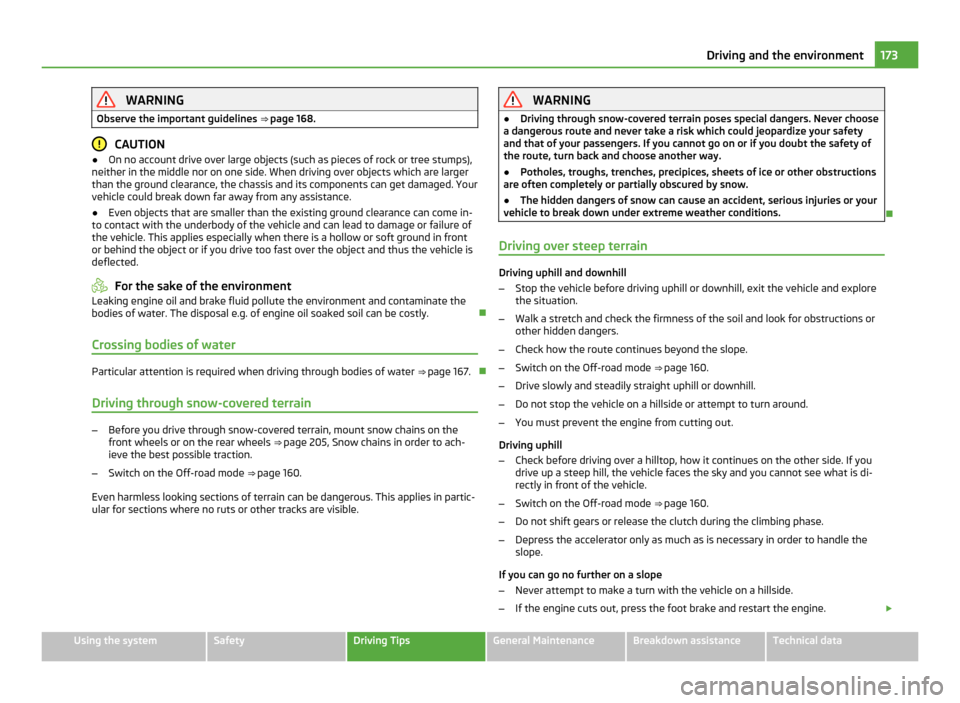
WARNING
Observe the important guidelines ⇒ page 168. CAUTION
● On no account drive over large objects (such as pieces of rock or tree stumps),
neither in the middle nor on one side. When driving over objects which are larger
than the ground clearance, the chassis and its components can get damaged. Your
vehicle could break down far away from any assistance.
● Even objects that are smaller than the existing ground clearance can come in-
to contact with the underbody of the vehicle and can lead to damage or failure of
the vehicle. This applies especially when there is a hollow or soft ground in front
or behind the object or if you drive too fast over the object and thus the vehicle is
deflected. For the sake of the environment
Leaking engine oil and brake fluid pollute the environment and contaminate the
bodies of water. The disposal e.g. of engine oil soaked soil can be costly.
Crossing bodies of water Particular attention is required when driving through bodies of water
⇒
page 167.
Driving through snow-covered terrain –
Before you drive through snow-covered terrain, mount snow chains on the
front wheels or on the rear wheels ⇒ page 205, Snow chains in order to ach-
ieve the best possible traction.
– Switch on the Off-road mode ⇒ page 160
.
Even harmless looking sections of terrain can be dangerous. This applies in partic-
ular for sections where no ruts or other tracks are visible. WARNING
● Driving through snow-covered terrain poses special dangers. Never choose
a dangerous route and never take a risk which could jeopardize your safety
and that of your passengers. If you cannot go on or if you doubt the safety of
the route, turn back and choose another way.
● Potholes, troughs, trenches, precipices, sheets of ice or other obstructions
are often completely or partially obscured by snow.
● The hidden dangers of snow can cause an accident, serious injuries or your
vehicle to break down under extreme weather conditions.
Driving over steep terrain Driving uphill and downhill
–
Stop the vehicle before driving uphill or downhill, exit the vehicle and explore
the situation.
– Walk a stretch and check the firmness of the soil and look for obstructions or
other hidden dangers.
– Check how the route continues beyond the slope.
– Switch on the Off-road mode ⇒ page 160
.
– Drive slowly and steadily straight uphill or downhill.
– Do not stop the vehicle on a hillside or attempt to turn around.
– You must prevent the engine from cutting out.
Driving uphill
– Check before driving over a hilltop, how it continues on the other side. If you
drive up a steep hill, the vehicle faces the sky and you cannot see what is di-
rectly in front of the vehicle.
– Switch on the Off-road mode
⇒ page 160
.
– Do not shift gears or release the clutch during the climbing phase.
– Depress the accelerator only as much as is necessary in order to handle the
slope.
If you can go no further on a slope
– Never attempt to make a turn with the vehicle on a hillside.
– If the engine cuts out, press the foot brake and restart the engine. £ 173
Driving and the environment Using the system Safety Driving Tips General Maintenance Breakdown assistance Technical data